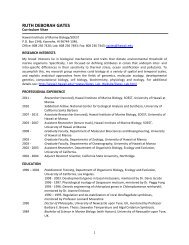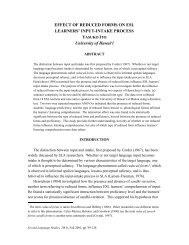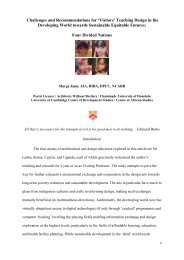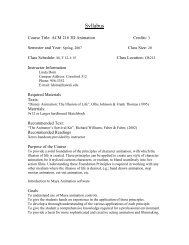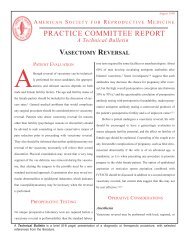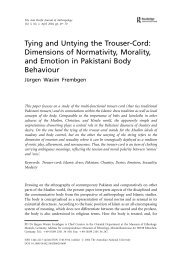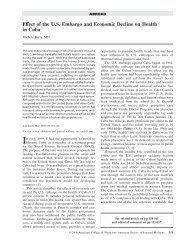Treatment of Neurosyphilis with Ceftriaxone (PDF)
Treatment of Neurosyphilis with Ceftriaxone (PDF)
Treatment of Neurosyphilis with Ceftriaxone (PDF)
Create successful ePaper yourself
Turn your PDF publications into a flip-book with our unique Google optimized e-Paper software.
415<br />
CASE REPORT<br />
<strong>Treatment</strong> <strong>of</strong> neurosyphilis <strong>with</strong> ceftriaxone<br />
S Shann, J Wilson<br />
...............................................................................................................................<br />
Sex Transm Infect 2003;79:415–416<br />
The first choice treatment for late syphilis is penicillin. Other<br />
than doxycycline, which penetrates the CNS, there are few<br />
alternatives for the treatment <strong>of</strong> neurosyphilis. We report a<br />
case <strong>of</strong> successful treatment <strong>of</strong> symptomatic neurosyphilis<br />
<strong>with</strong> parenteral ceftriaxone.<br />
The first choice treatment for late syphilis is penicillin. 1<br />
Other than doxycycline, which penetrates the CNS, there<br />
are few alternatives for the treatment <strong>of</strong> neurosyphilis.<br />
We report a case <strong>of</strong> successful treatment <strong>of</strong> symptomatic<br />
neurosyphilis <strong>with</strong> parenteral ceftriaxone.<br />
CASE REPORT<br />
A 61 year old heterosexual man who had served in the armed<br />
forces abroad was referred to the department <strong>of</strong> genitourinary<br />
medicine <strong>with</strong> a diagnosis <strong>of</strong> symptomatic neurosyphilis<br />
in September 1997.<br />
Six months before this he had been admitted to hospital<br />
<strong>with</strong> a history <strong>of</strong> expressive dysphasia and a left sided<br />
hemiparesis. His behaviour had been noted to be ‘‘out <strong>of</strong><br />
character’’ for a week before the admission. A computed<br />
tomograph (CT) scan revealed patchy ischaemic change,<br />
especially <strong>of</strong> the left frontal lobe. A carotid duplex scan and<br />
ECG were normal but an echocardiogram revealed a trivial<br />
degree <strong>of</strong> aortic regurgitation. His neurological abnormalities<br />
resolved over several days and he was discharged.<br />
In June 1997 he was reviewed in the neurology outpatient<br />
clinic <strong>with</strong> a history <strong>of</strong> transient dysphasia and impaired use<br />
<strong>of</strong> his right hand. He had developed marked short term<br />
memory loss and was unable to perform simple tasks. On<br />
examination he was generally tremulous and dysarthric but<br />
<strong>with</strong> normal tendon reflexes, tone, power, pain, and vibration<br />
sensation and proprioception. A magnetic resonance imaging<br />
(MRI) scan revealed generalised prominence <strong>of</strong> CSF spaces<br />
disproportionate to the patient’s age and small vessel<br />
ischaemic damage <strong>with</strong>in both frontal lobes.<br />
He was readmitted to hospital in August 1997 <strong>with</strong> a<br />
history <strong>of</strong> frequent falls. He was confused and had delusions<br />
<strong>of</strong> persecution. Investigations revealed positive syphilis<br />
serology in blood and CSF (see table 1) and he was referred<br />
to the department <strong>of</strong> genitourinary medicine.<br />
A diagnosis <strong>of</strong> untreated symptomatic neurosyphilis was<br />
made <strong>with</strong> both cerebrovascular components and parenchymatous<br />
features <strong>of</strong> general paresis. He had a history <strong>of</strong><br />
anaphylaxis <strong>with</strong> penicillin and there were concerns about<br />
non-compliance <strong>with</strong> doxycycline. We decided to use<br />
ceftriaxone because <strong>of</strong> its good CNS penetration. There is a<br />
10% risk <strong>of</strong> cross sensitivity between penicillin and cephalosporins;<br />
therefore, he was admitted to hospital and given a<br />
test dose <strong>of</strong> 50 mg <strong>of</strong> ceftriaxone intravenously <strong>with</strong> full<br />
resuscitation facilities available. He was commenced on<br />
prednisolone 10 mg three times daily for 24 hours before<br />
and 48 hours after starting treatment because <strong>of</strong> the risk <strong>of</strong> a<br />
Jarisch-Herxheimer reaction causing neurological deterioration<br />
or acute coronary ostitis. He received 1 g <strong>of</strong> ceftriaxone<br />
once daily for 14 days.<br />
He was reviewed 7, 19, and 36 months after treatment <strong>with</strong><br />
repeat syphilis serology <strong>of</strong> blood and CSF (see table 1).<br />
Clinically he made some improvement in terms <strong>of</strong> his<br />
memory, speech, and mobility.<br />
DISCUSSION<br />
The recommended treatment for neurosyphilis is penicillin.<br />
Doxycycline and amoxycillin have been evaluated as second<br />
line options but as they are given orally, there may be<br />
adherence issues. The UK national guidelines 2 and the<br />
European guidelines for the management <strong>of</strong> syphilis 3 do<br />
not recommend ceftriaxone for the treatment <strong>of</strong> late syphilis.<br />
However, the CDC Sexually Transmitted Diseases <strong>Treatment</strong><br />
Guidelines 2002 4 suggest that it may be used as an alternative<br />
in penicillin allergic patients <strong>with</strong> neurosyphilis.<br />
<strong>Ceftriaxone</strong> has been proved to have good CNS penetration.<br />
A dose <strong>of</strong> 1 g daily achieves levels well above the MIC<br />
for Treponema pallidum <strong>of</strong> 0.0006 mg/ml. 5 It also differs from<br />
other cephalosporins by having an unusually long serum half<br />
life <strong>of</strong> approximately 7 hours. 6<br />
However there have been reports that intramuscular<br />
ceftriaxone may not be adequate treatment for neurosyphilis.<br />
5 A retrospective study <strong>of</strong> HIV infected individuals treated<br />
<strong>with</strong> ceftriaxone for asymptomatic neurosyphilis or latent<br />
syphilis revealed a 23% failure rate. 7 Another study suggested<br />
that intravenous ceftriaxone may be an alternative to<br />
penicillin for treatment <strong>of</strong> HIV infected patients <strong>with</strong> neurosyphilis<br />
complicating early syphilis infection. However, in<br />
this setting, disease may be confined to the meninges and<br />
Table 1 Blood and CSF parameters before and after<br />
treatment <strong>with</strong> ceftriaxone<br />
Sept 97 April 98 April 99 Sept 00<br />
Blood<br />
TPHA* 1in256 1in128 1in64 .1 in 256<br />
FTA abs Pos Pos Pos Pos<br />
RPR 1 in 128 1 in 32 1 in 64 1 in 16<br />
Albumin (g/l) 41 40 - 44<br />
IgG (g/l) 14.1 9.9 - 15<br />
Glucose (mmol/l) 4.3 3.7 - -<br />
CSF<br />
TPHA* 1 in 64 1 in 32 1 in 32 .1 in 256<br />
FTA abs Pos Pos Pos Pos<br />
RPR 1 in 4 neg 1 in 2 neg<br />
Protein (g/l) 2.03 0.63 - 0.55<br />
Albumin (mg/l) - 418 - 262<br />
IgG (mg/l) - 97 .120 81<br />
White cells (/l) 32610 6 ,1610 6 - ,1610 6<br />
Glucose (mmol/l) 2.5 2.8 - -<br />
IgG index (,0.70) - 0.94 - 0.91<br />
Albumin quotient<br />
(,7.8)<br />
- 10.45 - 5.95<br />
TPHA = Treponema pallidum haemagglutination; FTA = fluorescent<br />
treponemal antibody; RPR = rapid plasmin reagin; TPPA = Treponema<br />
pallidum particle agglutination.<br />
*In January 2000 the laboratory began monitoring TPPA instead <strong>of</strong> TPHA.<br />
www.sextransinf.com
416 Shann, Wilson<br />
may be easier to cure than disease <strong>of</strong> longer duration that<br />
could involve meninges and brain parenchyma. 8<br />
The patient in our case had evidence <strong>of</strong> both cerebrovascular<br />
and parenchymal disease. He received 14 days <strong>of</strong><br />
ceftriaxone (3 days intravenously and 11 days intramuscularly)<br />
and was followed up for 36 months <strong>with</strong> blood and CSF<br />
analysis. His blood RPR fell from 1 in 128 pre-treatment to 1<br />
in 16 (a threefold reduction) 36 months after treatment. His<br />
CSF TPHA and FTA abs have remained detectable but the<br />
RPR was negative on the last occasion. The protein level in<br />
the CSF has consistently declined from 2.03 g/l to 0.55 g/l as<br />
have the CSF albumin and IgG levels. The IgG index remains<br />
elevated but the albumin quotient has normalised. Even after<br />
successful treatment these latter two parameters may remain<br />
abnormal. 3<br />
There are few other reports <strong>of</strong> successful treatment <strong>of</strong><br />
symptomatic neurosyphilis in HIV negative individuals<br />
<strong>with</strong> ceftriaxone. There is a single case <strong>of</strong> treatment <strong>of</strong><br />
asymptomatic neurosyphilis 9 and <strong>of</strong> treatment <strong>of</strong> meningomyelitis<br />
complicating secondary syphilis. 10 Our case suggests<br />
that ceftriaxone may be a useful alternative in HIV negative<br />
patients <strong>with</strong> neurosyphilis, but because <strong>of</strong> the doubt about<br />
its efficacy in those who are co-infected, a larger study <strong>with</strong><br />
CSF levels <strong>of</strong> ceftriaxone should be performed.<br />
.....................<br />
Authors’ affiliations<br />
S Shann, J Wilson, Department <strong>of</strong> Genitourinary Medicine, Leeds<br />
General Infirmary, Great George Street, Leeds LS1 3EX, UK<br />
Correspondence to: Dr S Shann, Department <strong>of</strong> Genitourinary<br />
Medicine, Sunnybank Wing, Leeds General Infirmary, Great George<br />
Street, Leeds LS1 3EX, UK; siobhan.mcmyler@leedsth.nhs.uk<br />
Accepted for publication 27 February 2003<br />
REFERENCES<br />
1 Hahn RD, Webster B, Weickhardt G, et al. The results <strong>of</strong> treatment <strong>of</strong> 1086<br />
general paralytics the majority <strong>of</strong> whom were followed up for more than 5<br />
years. J Chron Dis 1958;7:209–27.<br />
2 Clinical Effectiveness Group. UK national guidelines on STIs and closely<br />
related conditions. Sex Transm Infect 1999;75(Supp l).<br />
3 Goh BT, Van Voorst Vader PC. European guideline for the management <strong>of</strong><br />
syphilis. Int J STD AIDS 2001;12(suppl 3):14–26.<br />
4 Centers For Disease Control And Prevention. Sexually transmitted diseases<br />
treatment guidelines 2002. MMWR 2002;51(RR-6):18–26.<br />
5 Marra CM, Slatter V, Tartaglione TA, et al. Evaluation <strong>of</strong> aqueous penicillin G<br />
and ceftriaxone for experimental neurosyphilis. (letter) J Infect Dis<br />
1992;165:396–7.<br />
6 Steele RW. <strong>Ceftriaxone</strong> therapy <strong>of</strong> meningitis and serious infections. Am J<br />
Med 1984;77(4C):50–3.<br />
7 Dowell ME, Ross PG, Musher DM, et al. Response <strong>of</strong> latent syphilis or<br />
neurosyphilis to ceftriaxone therapy in persons infected <strong>with</strong> human<br />
immunodeficiency virus. Am J Med 1992;93:481–8.<br />
8 Marra CM, Boutin P, McArthur JC, et al. A pilot study evaluating<br />
ceftriaxone and penicillin G as treatment agents for neurosyphilis in<br />
human immunodeficiency virus-infected individuals. Clin Infect Dis<br />
2000;30:540–4.<br />
9 Hook EW, Baker-Zander SA, Moskovitz BL, et al. <strong>Ceftriaxone</strong> therapy for<br />
asymptomatic neurosyphilis. Case report and Western blot analysis <strong>of</strong><br />
serum and cerebrospinal fluid IgG response to therapy. Sex Transm Dis<br />
1986;13(Suppl 3):185–8.<br />
10 Gentile JH, Viviani C, Sparo MD, et al. Syphilitic meningomyelitis treated<br />
<strong>with</strong> ceftriaxone: case report. Clin Infect Dis 1998;26:528.<br />
www.sextransinf.com



